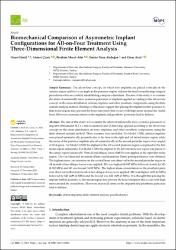Biomechanical comparison of asymmetric implant configurations for all-on-four treatment using three-dimensional finite element analysis
Citation
Gönül O, Çicek A, Afat İM, Akdoğan ET, Atalı O. Biomechanical Comparison of Asymmetric Implant Configurations for All-on-Four Treatment Using Three-Dimensional Finite Element Analysis. Life. 2022; 12(12).Abstract
Simple Summary The all-on-four concept, in which two implants are placed vertically in the anterior region and two at an angle in the posterior region, reduces the need for multi-stage surgical procedures while successfully rehabilitating complete edentulism. The aim of this study is to examine the effect of unilaterally more posterior placement of implants applied according to the all-on-four concept on the stress distribution on bone, implants and other prosthetic components, using the finite element analysis method. Findings of this study suggest that placing the implant further posterior to first molar region may prevent the bone resorption that occurs with high stress around the crestal bone. However, increased stress on the implants and prosthetic parts may lead to failures. The aim of this study is to examine the effect of unilaterally more posterior placement of implants (Straumann BLT 4.1 mm in diameter and 12 mm long) applied according to the all-on-four concept on the stress distribution on bone, implants, and other prosthetic components, using the finite element analysis method. Three scenarios were modelled: For Model 1 (M1), anterior implants were placed symmetrically perpendicular to the bone in the right and left lateral incisor region, while the necks of the posterior implants placed symmetrically in the second premolar region were angled at 30 degrees. For Model 2 (M2) the implant in the left second premolar region was placed to the first molar region unilaterally. For Model 3 (M3) the implant in the left lateral incisor region was placed to the canine region unilaterally. Vertical and oblique forces (100 N) were applied in the right first molar region. The von Mises and maximum (Pmax) and minimum (Pmin) principal stresses were obtained. The highest stress concentration on the cortical bone was observed in the second premolar region in all models when oblique forces were applied. M1 was highest (8.992 MPa) followed closely by M3 (8.780 MPa) and M2 was lowest (3.692 MPa). The highest stress concentration on the prosthetic parts was observed in this framework when oblique forces were applied. M2 was highest (621.43 MPa) followed by M3 (409.16 MPa) and the lowest was M1 (309.43 MPa). It is thought that placing the implant further posterior to first molar region may prevent the bone resorption that occurs with high stress around the crestal bone. However, increased stress on the implants and prosthetic parts may lead to failures.
Source
LifeVolume
12Issue
12URI
https://www.mdpi.com/2075-1729/12/12/1963https://doi.org/10.3390/life12121963
https://hdl.handle.net/20.500.12780/655


















